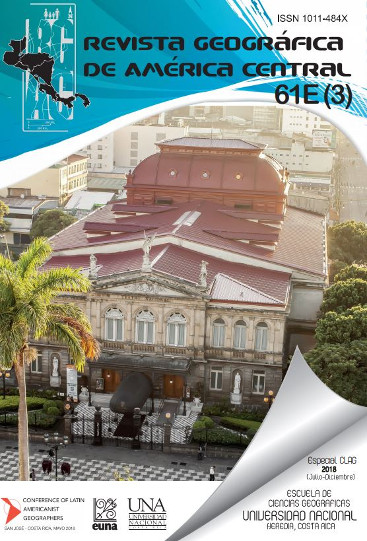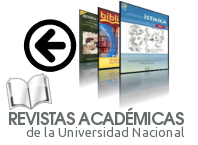The Making of Geographies: Exploring Integral Territory and Memory within Indigenous Protest
DOI:
https://doi.org/10.15359/rgac.61-3.8Keywords:
Collective memory; decoloniality; indigenous movement; neoliberalism; PeruAbstract
The study of the relation between memory and geography has been mainly focused on the role of the built space (e.g. museums, monuments, heritage sites, and artifacts) with the production of sites of memorialization, as well as the use of space through performance or rituals in (re)creating memories or counter-memories by social groups. The reconstruction and recovering of an 'integral territory' among Amazonian peoples, which they describe as their ancestral way of living, is today also a modern project to define and reassert the control of their territories. In the light of a critical review of the literature on memory in geography and narrative analysis of interviews and documents elaborated by indigenous groups, I propose a conceptual framework to study the so-called anti-neoliberal protests of 2008-2009 in the Peruvian Amazon drawing on collective memory and decolonial theories.
References
Benavides, M. (2010). Industrias extractivas, protesta indígena y consulta en la Amazonía peruana. Anthropologica, 28: 263-287.
Brown, M. (1984). Una paz incierta: historia y cultural de las comunidades aguarunas frente al impacto de la carretera marginal. Lima: CAAAP.
CORPI, Racimos de Ungurahui, y Grupo Internacional de Trabajo sobre Asuntos Indígenas (IWGIA). (2002). Una historia para el futuro: Territorios y Pueblos Indígenas en Alto Amazonas. Santa Cruz de la Sierra: Sirena Color.
Courtheyn, C. (2015). “‘Memory is the strength of our resistance’: an ‘other politics’ through embodied and material commemoration in the San José Peace Community, Colombia.” Social & Cultural Geography, 17(7): 933-958.
Espinosa, O. (2009). “¿Salvajes opuestos al progreso? Aproximaciones históricas y antropológicas a las movilizaciones indígenas en la Amazonía peruana.” Anthropologica, 27: 123-168.
Finer, M. y M. Orta-Martínez. (2010). “A second hydrocarbon boom threatens the Peruvian Amazon: trends, projections, and policy implications.” Environmental Research Letters, 5: 1-10.
Garcia, A. (2007, 28 de octubre). “El síndrome del perro del hortelano”. El Comercio. Recuperado: https://elcomercio.pe/edicionimpresa/html/2007-10-28/el_sindrome_del_perro_del_hort.html
García Hierro, P. (2017). “Argumentos básicos acerca de la irracionalidad e inconstitucionalidad del contrato de cesión en uso de suelos forestales en territorios indígenas.” Recuperado: http://nuestrosderechos.pe/argumentos-basicos-acerca-de-la-irracionalidad-e-inconstitucionalidad-del-contrato-de-cesion-en-uso-de-suelos-forestales-en-territorios-indigenas/. [Artículo original en: www.justiciaviva.org.pe, 11 de setiembre de 2014].
Garra, S. y R. Riol. (2014). “Por el curso de las quebradas hacia el ‘territorio integral indígena’: Autonomía, frontera y alianza entre los awajún y wampis.” Anthropologica, 32: 41-70.
Greene, S. (2006). “Getting over the Andes: The Geo-Eco-Politics of Indigenous Movements in Peru’s Twenty-First Century Inca Empire.” Journal of Latin American Studies, 38: 327-354. DOI: http://dx.doi.org/10.1017/S0022216X06000733.
Johnson, N. y G. Pratt. (2009). “Memory.” En R. Johnston, G. Pratt, M. Watts, y S. Whatmore (Eds.) The Dictionary of Human Geography (pp. 453-455). Recuperado de: https://ebookcentral-proquest-com.proxy.queensu.ca.
Halbwachs, M. (1992). On collective memory. Chicago: University of Chicago Press.
Hardt, M. and Reyes, A., (2012). “New Ways of Doing”: The Construction of Another World in Latin America: An Interview with Raúl Zibechi. South Atlantic Quarterly, 111(1), 165-191.
Harvey, D. (2005). “Space as a Key Word.” En Spaces of Neoliberalization: Towards a Theory of Uneven Geographical Development [2004 Hettner Lectures, Department of Geography, Heidelberg] (pp. 91-115). Stuttgart: Franz Steiner Verlag.
Hill, J. D. (2008). “Indigenous Peoples and the Rise of Independent Nation-States in Lowland South America.” En F. Salomon y S. B. Schwartz The Cambridge History of the Native Peoples of the Americas (pp. 704-764). http://dx.doi.org/10.1017/CHOL9780521630764.012
Hoelscher, S. y D.A. Alderman. (2004). “Memory and place: Geographies of a critical relationship.” Social & Cultural Geography (5) 3: 347-355.
Inoach, G. (2015). “Caminando con Perico.” En A. Chirif (Ed.) Querido Perico: Pedro García Hierro, defensor de los derechos de los pueblos indígenas (pp. 63-73). Lima: International Work Group for Indigenous Affairs (IWGIA).
Instituto Nacional de Estadística e Informática – INEI. (2009). Resultados Definitivos de las Comunidades Indígenas. Censos Nacionales 2007: XI de Población y VI de Vivienda. Resumen Ejecutivo. Lima: INEI.
Kneightley, E. (2010). “Remembering research: memory and methodology in the social sciences.” International Journal of Social Research Methodology, 13(1): 55-70.
Manacés, J. y C. Gómez. (2010). “Informe en Minoría de la Comisión Especial para Investigar y Analizar los Sucesos de Bagua”. Recuperado: http://www.caaap.org.pe/documentos/INFORME_MINORIA_CAPITULOS.pdf
Massey, D. (2005). For Space. London;Thousand Oaks, Ca; New Delhi: SAGE.
Merino, R. (2015). “The politics of indigenous self-determination: Extractive industries, states policies and territorial rights in the Peruvian Amazon.” PhD diss., University of Bath, United Kingdom.
Ministerio de Cultura. Pueblo Awajún. Base de datos de Pueblos Indígenas y Originarios. Recuperado: http://bdpi.cultura.gob.pe/pueblo/awajun
Noxolo, P. (2017). “Introduction: Decolonising geographical knowledge in a colonised and re-colonising postcolonial world.” Area, 49.3: 317-319.
Organization for the Development of the Border Communities of El Cenepa (ODECOFROC). (2010). A Chronicle of Deception: Attemps to transfer the Awajún Border Territory in the Cordillera del Cóndor to the Mining Industry (Report 5). International Work Group for Indigenous Affairs (IWGIA). Recuperado: http://www.iwgia.org/publications/search-pubs?publication_id=10
Orihuela, J.C. (2012). “The Making of Conflict-Prone Development: Trade and Horizontal Inequalities in Peru.” European Journal of Development Research, 24 (5): 688-705.
Regan Mainville, J. (2010). “Los awajún y wampís contra el Estado: una reflexión sobre antropología política.” Investigaciones Sociales, 14: 19-35.
Rénique, G. (2009). “Law of the Jungle in Peru: Indigenous Amazonian Uprising against Neoliberalism.” Socialism and Democracy, 23(3), 117-135. DOI: 10.1080/08854300903290835.
Rivera Cusicanqui, S. (2010). Oprimidos, pero no vencidos: Luchas del Campesinado Aymara y Quechwa, 1900-1980 (4ª. Ed.). La Paz: La Mirada Salvaje.
Romio, S. (2014). “Entre discurso político y fuerza espiritual. Fundación de las organizaciones indígenas awajún y wampis (1977-1979).” Anthropologica, 32: 139-158.
Stetson, G. (2012). “Oil Politics and Indigenous Resistance in the Peruvian Amazon: The Rhetoric of Modernity Against the Reality of Coloniality.” The Journal of Environment & Development, 21(1): 76-97.
Smith, R.C. (2003). “Los indígenas amazónicos suben al escenario internacional: Reflexiones sobre el accidentado camino recorrido”. En F. Morin y R. Santana (Eds.). Lo transnacional: Instrumento y desafío para los pueblos indígenas (203-241). Quito: Ediciones Abya Yala.
Stetson, G. (2012). “Oil Politics and Indigenous Resistance in the Peruvian Amazon: The Rhetoric of Modernity Against the Reality of Coloniality.” The Journal of Environment & Development, 21(1): 76-97.
Surrallés, A. y P. García Hierro. (2004). “Introduction.” En Tierra Adentro: Territorio Indígena y Percepción del Entorno, #39, (pp. 9-22). Recuperado: http://www.iwgia.org/publicaciones/buscar-publicaciones?publication_id=331
Till, K. E. (2012). “Wounded cities: Memory-work and a place-based ethics of care.” Political Geography (31) 1: 3-14.
Till, K. E. and Kuusisto-Arponen, A.K. (2015). “Towards responsible geographies of memory: Complexities of place and the ethics of remembering.” Erdkunde (69) 4: 291-306.
Tuck, E. (2009). “Suspending Damage: A Letter to Communities.” Harvard Educational Review (79) 3: 409-427.
Tuck, E. and Yang, K. W. (2014). “R-Words: Refusing Research.” En D. Paris y M. T. Winn (Eds.) Humanizing research: Decolonizing qualitative inquiry with youth and communities
Downloads
Published
How to Cite
Issue
Section
License
Proposed policy for journals offering Open Access
Authors publishing their works in the Journal acknowledge and agree to the following terms:
a) Authors retain the copyrights to their works and guarantee the Journal the right to be the first to publish their works, under the Creative Commons License Attribution-NonCommercial-ShareAlike 4.0 International, CC BY-NC-SA 4.0 International (https://creativecommons.org/licenses/by-nc-sa/4.0/deed.es), which allows others to share works upon complying with the acknowledgment of authorship and mention of the Journal as the original publisher of the work.
b) Authors are permitted to separately establish additional agreements for the non-exclusive distribution of the official edition of the work published in the Journal (for example, authors may desire to place the work in an institutional repository or incorporate it into a book that is to published elsewhere) so long they acknowledgment to recognize the Journal as the original publisher. The aforementioned additional agreements must respect the terms of the non-profit character and sharing philosophy of the original license (CC BY-NC-SA 4.0 International, https://creativecommons.org/licenses/by-nc-sa/4.0/deed.es).
c) Authors are encouraged to archive the post-print or editor/PDF version in Open Access repositories.







 REVGEO is licensed under https://creativecommons.org/licenses/by-nc-sa/4.0/deed.es
REVGEO is licensed under https://creativecommons.org/licenses/by-nc-sa/4.0/deed.es
.svg_4.png)

_(1).png)
_(1)_(1)_(1)_1.png)
(2)(1)(1)(1).png)
